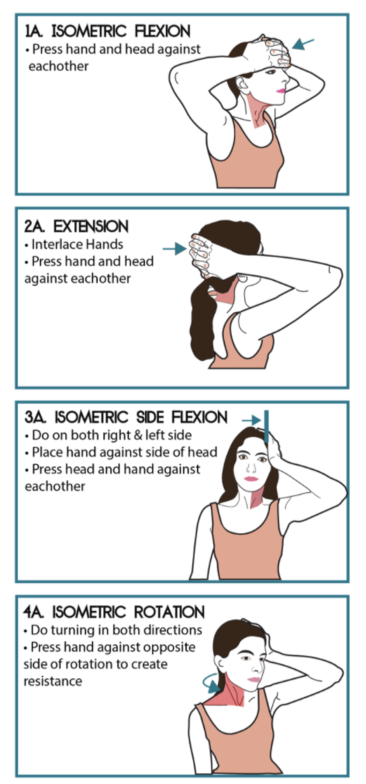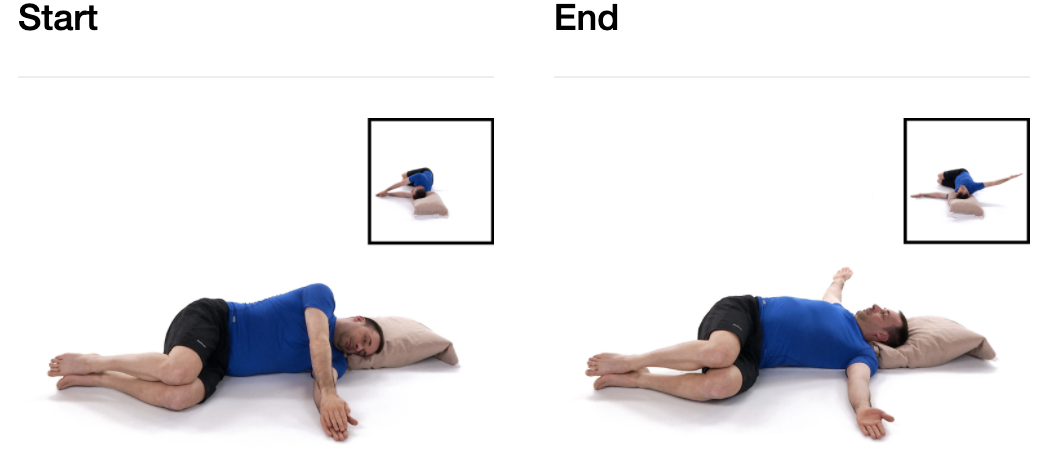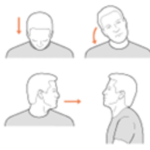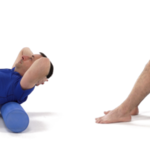Over the course of a lifetime most of us will experience an acute episode of neck pain. Whether it was caused by sleeping awkwardly or from checking your blind spot too quickly while driving many of us do not know what to do next. Regardless of the cause it is encouraged to have a medical professional perform a proper examination on any injury before self-treatment, but it is not always possible to have that done immediately. The following are some simple exercises that you can try at home to help manage your pain and symptoms.
The first step anyone should take is to keep moving your neck. On many occasions, when pain develops, we actively avoid moving our neck because it hurts! This can cause the joints and muscles to seize and make recovery longer and harder. You should try to move your neck through any tolerable range of motion.
In some cases, your range of motion may be significantly decreased, but it is important to maintain whatever range of motion is tolerable. If your pain increases significantly with motion while seated or standing, you can try and perform your range of motion exercises while laying on your back. Taking gravity out of the equation can often increase the amount of tolerable mobility that you have.
Go through all the different motions that our neck moves in. This includes looking over each shoulder (rotation,) bringing one ear to your shoulder (lateral bend,) looking up and down with your head (flexion/extension,) and finally cervical protraction and retraction. With each repetition go as far as you can tolerate without increasing your symptoms and repeat. You may find your motion will increase with each repetition and each set.
Once you have performed basic range of motion exercises the next step is to begin activating your neck muscles. The best way to activate your muscles when you are experience a lot of neck pain is to perform what are called “isometric contractions.” An isometric contraction refers to activating a muscle without changing its length.
The goal is to perform isometric contractions in all the same ranges of motion as we previously discussed.
Begin with rotational isometrics. Bring your hand to the side of your head and try and turn your head into your hand. Use your hand to stop your head from turning but continue to activate the musculature as though you would be looking over your shoulder. Meet the force of your head turning with your hand. Hold this contraction for 10 second. Next perform it looking over the other shoulder.
This same technique can be applied to your lateral bend motions and your flexion/extension ranges of motion. The goal is to activate all the muscles that move your head without having to produce movement. These types of contractions can not only help build back strength in your injured neck, but they can also help moderate your pain.
Finally, once you have increased your range of motion and then safely activated your cervical musculature the final group of exercises to try and home for acute neck pain is thoracic mobility.
On some occasions we may experience too much pain in a certain region to perform exercises. When this occurs, we can work adjacent body regions and have a positive impact on your recovery. The most important adjacent region to work on when you have neck pain is the upper back (aka the thoracic spine.) When the upper back is restricted or immobile, the neck takes on an increased stress. This can not only irritate the pain but in some cases, it can be a underlying factor leading to your pain. The following are some thoracic mobility exercise that can be used to help unload the cervical spine and manage your neck pain.
Thoracic spine extension over a foam roller.
While performing this exercise, roll the foam roller through the upper back until you feel a spot that is tight or restricted. Support your neck and extend backwards over the foam roller. Hold for 10 seconds and repeat.
The last exercise is to address limited thoracic rotation. An exercise called a “Can Opener” can be performed.
The exercise begins laying on your side with your knees and hands together. Slowly rotated only your upper body until you can no longer keep your knees together. Finish the exercise by bringing your hands back together.
These exercises are not designed to treat all forms of neck pain, rather they are a great general place to start!













